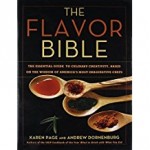 Cooking can be a very creative process if you have an understanding of the aesthetic of flavor. The Flavor Bible by Karen Page and Andrew Dorneburg presents a guide to flavor affinities that makes recipes less important and frees a cook to create unique dishes. Based on the experiences of many of the top and innovative chefs in America, the authors provide tables that show how flavors of hundreds of ingredients relate to one another so that cooks can create new and delicious flavor combinations using the vast number of new ingredients that are quickly becoming available.
Cooking can be a very creative process if you have an understanding of the aesthetic of flavor. The Flavor Bible by Karen Page and Andrew Dorneburg presents a guide to flavor affinities that makes recipes less important and frees a cook to create unique dishes. Based on the experiences of many of the top and innovative chefs in America, the authors provide tables that show how flavors of hundreds of ingredients relate to one another so that cooks can create new and delicious flavor combinations using the vast number of new ingredients that are quickly becoming available.
The book consists primarily of tables of more than six hundred ingredients listed alphabetically with modern-day compatible flavors. Believing that the aesthetic of flavor is a combination of taste, mouthfeel, aroma, and a hard to define “X” factor, the authors also provide information on seasonal availability, basic taste, weight, volume, primary function, and cooking tips, concluding with flavor affinities, and in some cases, pairings to avoid. Dozens of cuisines are also included and insets give new cooking techniques, suggest dishes, and relate the experiences of individual chefs. The entry for eggs, for example tells us that the taste is sweet to astringent, the weight is light to medium, the volume is quiet, and the cooking techniques are baking boiling, frying, poaching and scrambling. Eggs pair well with over forty other ingredients but are especially good with asparagus, basil, potatoes, and spinach; cranberries should be avoided. Flavor infinities include: mushrooms and red wine; potato and sausage; and bacon, cheese, and onions. Suggestions for egg dishes go from poached eggs with polenta, to goat cheese omelet, to zucchini-Parmesan cheese frittata.
There are no recipes but lots of suggestions. The photographs provide color to enliven the work but are not particularly informative. The layout is clear and easy to read. If you are serious about creative cooking this is a must have book!
To buy The Flavor Bible from Amazon.com Click Here.